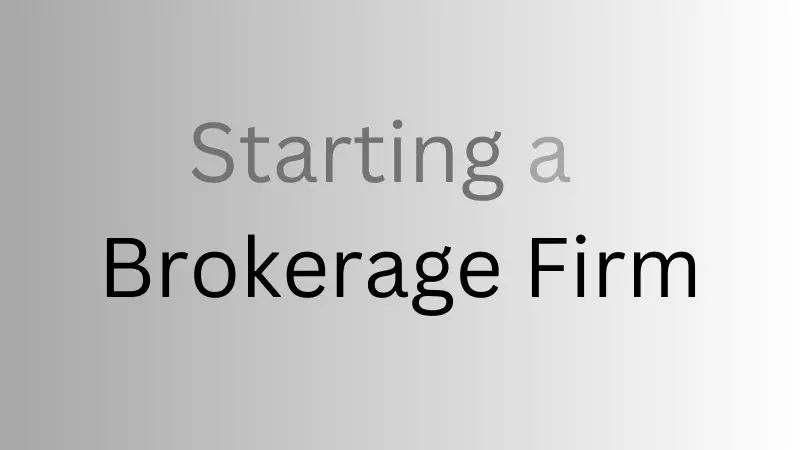10 Steps to Starting a Brokerage Firm?

Starting a Brokerage Firm can be a complex process, but with careful planning and execution, it can be a rewarding venture. Below, we will outline 10 key steps involved in Starting a Brokerage Firm.
Step 1: Develop a Business Plan
Before starting a brokerage firm, it is important to develop a comprehensive business plan. This plan should outline the firm’s mission, objectives, and strategies for achieving those objectives. It should also include financial projections, marketing plans, and operational details.
In developing the business plan, it is important to conduct market research and identify the target market for the firm’s services. This research should include an analysis of the competition, pricing strategies, and other factors that may impact the success of the brokerage firm.
Step 2: Obtain Licenses and Registrations
The next step in starting a brokerage firm is to obtain the necessary licenses and registrations. This typically includes registering the firm with the appropriate regulatory bodies, such as the Securities and Exchange Commission (SEC) in the United States. It may also include obtaining licenses to sell securities, such as the Series 7 license in the United States.
It is important to consult with legal and financial professionals to ensure that all necessary licenses and registrations are obtained and that the firm is in compliance with all relevant regulations.
Step 3: Build a Team
Building a strong team is essential to the success of any brokerage firm. This includes hiring experienced brokers, traders, and support staff. It is important to create a culture that fosters collaboration, innovation, and excellence.
In addition to hiring staff, it may be necessary to establish relationships with other service providers, such as custodians, clearinghouses, and technology providers.
Step 4: Develop a Technology Infrastructure
Technology is a critical component of any modern brokerage firm. It is important to develop a technology infrastructure that supports efficient trading, account management, and reporting.
This may include investing in a robust trading platform, customer relationship management (CRM) software, and other tools to help manage the firm’s operations. It may also include developing a website and social media presence to help promote the firm’s services and engage with clients.
Step 5: Establish Risk Management Procedures
Risk management is a key consideration for any brokerage firm. It is important to establish procedures for monitoring and managing risk, including market risk, credit risk, and operational risk.
This may include implementing risk management software, developing policies and procedures for risk management, and training staff on risk management best practices.
Step 6: Develop a Marketing Strategy
A strong marketing strategy is essential to the success of any brokerage firm. This may include developing a brand identity, creating marketing materials, and identifying the most effective channels for reaching potential clients.
It is important to invest in marketing and advertising to raise awareness of the firm’s services and differentiate it from competitors.
Step 7: Launch the Firm
Once all of the necessary preparations have been made, it is time to launch the brokerage firm. This may include hosting launch events, reaching out to potential clients, and promoting the firm’s services through advertising and marketing campaigns.
It is important to monitor the firm’s performance closely in the early stages and make adjustments as necessary to ensure that it is on track to meet its objectives.
Step 8: Establish Clear Client Communication
Establishing clear communication with clients is crucial for the success of any brokerage firm. This includes providing transparency about fees and investment strategies, as well as responding to client inquiries and concerns in a timely manner.
It is important to establish client communication channels such as email, phone, and live chat support. Additionally, it may be helpful to provide clients with educational materials and regular updates on market trends and investment opportunities.
Step 9: Continuously Monitor and Adapt to Market Changes
Markets are constantly evolving, and it is important to continuously monitor and adapt to these changes. This includes staying informed about economic and political events, as well as monitoring the performance of individual securities and investment portfolios.
It is important to regularly review and adjust the firm’s investment strategies and risk management procedures in response to changing market conditions.
Step 10: Focus on Building Long-Term Relationships
Building long-term relationships with clients is key to the success of any brokerage firm. This requires a focus on providing exceptional customer service and delivering consistent investment returns.
It is important to regularly review and adjust the firm’s investment strategies and risk management procedures in response to changing market conditions. Additionally, it may be helpful to provide clients with educational materials and regular updates on market trends and investment opportunities.
Conclusion
Starting a brokerage firm requires a significant investment of time, money, and resources. However, with careful planning, execution, and ongoing management, it is possible to build a successful brokerage firm that delivers value to clients and generates long-term growth and profitability.
By following the steps outlined in this article, it is possible to establish a strong foundation for the brokerage firm, build a strong team, develop a technology infrastructure, establish risk management procedures, and develop a marketing strategy. By focusing on building long-term relationships with clients and continuously monitoring and adapting to market changes, it is possible to build a successful and sustainable brokerage firm.


